Without proper attention, your car’s battery can corrode, possibly leaving you without a working car. Corrosion can drain power out of a battery and shorten its life.
Battery corrosion is typically apparent at the terminals, a problem that can be resolved by careful cleaning.
How to Remove Corrosion From a Car Battery
1. Assemble Your Tools and Supplies
Gather the essential tools and supplies required to tackle this job. You will need to put on a pair of safety glasses and work gloves. Avoid wearing your good clothes as you will come in contact with grease and dirt.
You will need a stiff wire brush, a cup of lukewarm or cold water, a box of baking soda, a teaspoon and rags. An old toothbrush, pliers, a wrench and petroleum jelly round out your tools and supplies.
2. Disconnect the Battery
Park your car outside, preferably in your driveway or in the street. Lift and secure the car’s hood, then locate the battery. In some vehicles, the battery can be found underneath the rear passenger seat or in the trunk.
Take the wrench and pliers to the black (negative) connection or post and loosen same. Repeat this process with the red (positive) connection. Place your tools away from the battery cables to avoid contact resulting in an electrical shock.
3. Remove Car Battery Corrosion
Take your teaspoon and fill it with baking soda. Combine this powder with your cup of water and stir.
Gradually pour approximately half the solution over each battery post, then place this mixture to the side. Take your wire brush or old toothbrush and brush off the remaining corrosion. You can dip the brush into the mixture or pour the remaining amount over the terminals as needed.
For tough cases allow this solution to penetrate for at least five minutes. Continue brushing until all corrosion has been removed.
4. Preparation and Clean Up
Dry off the battery, wiping it down with a clean rag. Wipe down the battery cables. Discard your rag.
Apply petroleum directly to each battery post liberally. Reconnect the battery cables beginning with the positive connection followed by the negative connection. Tighten each connection with your pliers or wrench.
Remove all tools and supplies, close the hood and start your car to ensure that it will run. You might also consider moving the car away from the work area and bringing out the garden hose to wash away the corrosive residue left on the ground.
Getting the Job Done
Battery corrosion removal and care can be successfully handled within 15 to 20 minutes. Make this an annual task and you will avoid potential problems that can leave you stranded or shorten your battery’s useful life.
See Also – Care Tips for Your New Vehicle
Photo courtesy of Mark Buckawicki, The Public Domain Project
- 2024 Mazda CX-50: A Compact SUV with Premium Aspirations - Apr 15, 2024
- 2024 Ford Mustang (Iconic Pony Car Evolves) - Apr 4, 2024
- 2024 Ford Maverick (Looks Like a Truck, Drives Like a Car) - Mar 28, 2024

